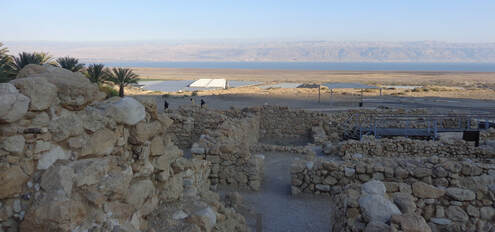|
Read: Psalm 119:105-112 (www.biblestudytools.com/nrs/psalms/119.html) Sing: Wonderful Words of Life, UMH 600 In the foothills on the northwestern shore of the Dead Sea a Bedouin goat and sheep-herder by the name of Mohammed Ahmed el-Hamed threw a rock into a cave in an attempt to drive out a missing animal. The sound of breaking pottery drew him into the cave, where he found seven clay jars containing scrolls that had been wrapped in linen for nearly two thousand years. This happened in 1946. Eventually parts of about 850 scrolls were found in eleven different caves in the area. These ancient manuscripts were in various states of decay and completeness. Only a few were intact, the largest being more than twenty-five feet long. Most were written in Hebrew, some in Aramaic, and a few in Greek. Most were on parchment, with a few on papyrus. Their preservation had been aided by the hot, dry climate. The Dead Sea Scrolls include at least fragments of every book of the Old Testament except the book of Esther. They are the oldest existing copies of the Old Testament and they generally confirm the accuracy of later manuscripts. The non-Biblical scrolls give a new insight into the Jewish society in which Christianity began. The prevailing view is that the scrolls were written or copied by a devout group of Essenes, a strict Jewish sect formed in reaction to what they saw as the religious laxity of the Judaism practiced in Jerusalem. The Essenes at Qumran lived an austere lifestyle in their remote desert surroundings. Study of the Jewish law went on in shifts around the clock. The community gained the admiration of the Roman statesman Pliny the Elder, who wrote, “They are unique and admirable beyond all other peoples in that they have no women, no sexual desire, no money, and only palm trees for company. Owing to the influx of newcomers, they are daily reborn in equal numbers.” The Essenes believed the end of the world was imminent. They never married because they wanted to be ritually pure when the Messiah appeared. The Essenes arrived in the area towards the end of the second century BC. In 31 BC there was a serious earthquake and the sect abandoned the site. Within twenty-five years they returned and rebuilt. The Qumran community was driven from its wilderness retreat by the Romans in 68 AD, leaving its library of scrolls hidden in caves for safe-keeping. Ruins of the sect’s communal site remain, including an aqueduct, cattle pen, cemeteries, cisterns, dining hall, kiln, kitchen, laundry room, pantry, pottery workshop, ritual baths, stable, watchtower, and writing room. Members of the sect lived in huts and tents nearby or from time to time occupied the caves they had dug to practice isolation. After the discovery of the first scrolls archeologists began looking for the center of the Essene activity in the area. A team of French archeologists excavated the area between 1951 and 1956 and found additional scrolls and early structures. These finds supported the theory that Qumran had indeed been the nucleus of the Essene community. The site became a National Park in 1967.
0 Comments
Leave a Reply. |
AuthorIn matters of faith, we at First United Methodist Church, Sealy put primary reliance on the Bible. In scripture, we understand that we are all God’s children; therefore, we will be a church that cares for the needs of our church and local community through prayer, deeds, inspiration, and love in the spirit of Christ. Archives
July 2020
Categories |
Location |
Our MissionCaring for the needs of our church and community through prayer, deeds, inspiration and love in the Spirit of Christ.
Sunday Worship: 10 am Adult & Children & Youth Sunday School 9 am First Kids Mother's Day Out (Tuesday & Thursday; 8am to 2pm; Ages 1-3) Rev Pat Bell, Pastor First United Methodist Church Sealy
200 Atchison Street Sealy, Texas 77474 979.885.2223 |
Contact Us |

 RSS Feed
RSS Feed